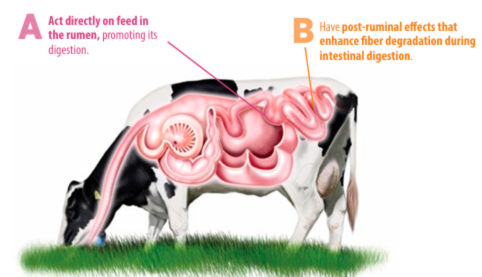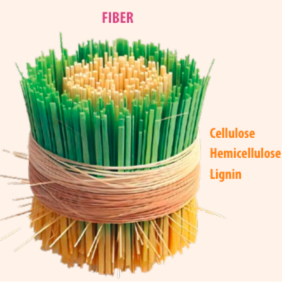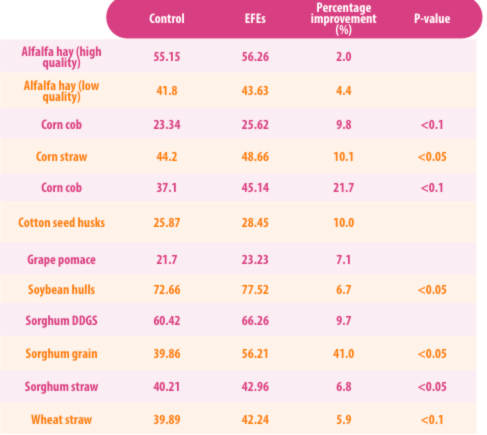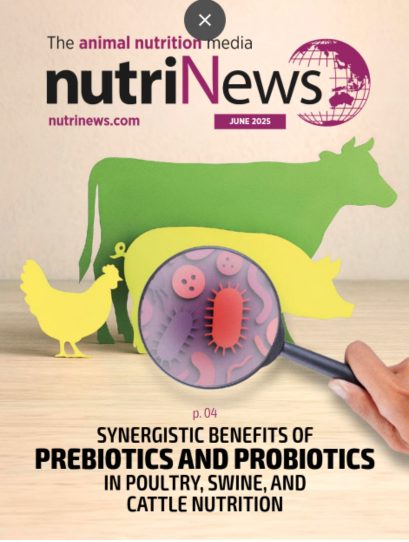CATALYZING THE EFFICIENCY AND THE SUSTAINABILITY IN THE LIVESTOCK PRODUCTION
The inclusion of enzymes in ruminant diets is a key tool to optimize their utilization, improving both efficiency and effectiveness. In addition, it helps prevent metabolic diseases, which not only benefits farm profitability, but also establishes itself as a fundamental pillar for sustainability.
![]()
Enzymes are proteins produced by cells to catalyze specific chemical reactions.
In the field of food and feed processing, most enzymes used are of microbial origin, obtained mainly from:
Fungi such as Trichoderma longibrachiatum, Aspergillus oryzae, and Aspergillus niger. |
Exogenous enzymes, those that are not part of the animal’s digestive system, are added to diets with the goal of increasing nutrient use efficiency and eliminating antinutritional factors.
In monogastric nutrition, their use is widely established, especially with phytases and amylases, which are part of virtually all feeds used in intensive production systems.
This is due to the inability of monogastric animals to produce certain enzymes needed to digest some components of their rations, making exogenous enzymes essential for maximizing digestibility.
|
In ruminants, the context is more complex due to the presence of the rumen, a unique ecosystem with a microbial population that plays a crucial role in the initial digestion of food. |
The enzymes produced by the ruminal microbiota are responsible for fermentation, aiding in the digestion of starch and fiber. However, studies have shown that this process is not always efficient, especially when animals are fed slow-digesting grains. This incomplete utilization is due to factors such as:
![]() The characteristics of the starch.
The characteristics of the starch.
![]() The physicochemical and biological conditions of the rumen.
The physicochemical and biological conditions of the rumen.
![]() The limited action of endogenous enzymes.
The limited action of endogenous enzymes.
To improve the degradation of fibers and starches, the inclusion of exogenous enzymes in the diets of dairy and beef cattle is key.
![]()
These enzymes increase the capacity for nutrient extraction and absorption, improving their availability and contributing to greater efficiency in animal production.
|
In this regard, the complete digestion of complex structures, such as the cell wall of forages or cereal grains, involves a large number of enzymes. |
In ruminants, enzymes can:


Fibrolytic enzymes: enhancing ruminal efficiency
To maximize the energy potential of forage and achieve maximum productive performance, it is essential to understand what fiber is and how its chemical composition influences its digestibility and utilization by the ruminal microbiome.
Fiber, which makes up a significant proportion of the plant cell wall, is mainly composed of structural carbohydrates divided into fractions such as cellulose, hemicellulose, and lignin.
However, less than 50% of these components are easily digested, limiting their efficient use.

Increasing the digestion of these cell walls by just 10% can make a notable difference, significantly reducing the solids present in the manure.

Enhancing this process relies heavily on including fibrolytic enzymes in the diet, as they:
» They stimulate fiber digestion.
» They promote dry matter (DM) intake.
In this regard, a meta-analysis of 10 studies highlighted that the use of fibrolytic enzymes not only increases dry matter intake but also boosts milk production by an average of 2.3 kg/day, resulting in a 4.6% improvement in feed efficiency.
|
Fibrolytic enzymes act by: » Enhancing the digestibility of dry matter and neutral detergent fiber (NDF). » Increase the production of volatile fatty acids. » Boosting ruminal activity. |
Although ruminants, compared to monogastrics, have a natural advantage in fiber fermentation due to the diversity of their ruminal microbiome, the digestion process is complex and occurs sequentially.
 Anaerobic fungi play a crucial initial role, releasing enzymes such as xylanases and cellulases that weaken the plant cell wall, thus facilitating the action of cellulolytic and hemicellulolytic bacteria specialized in breaking down cellulose and hemicellulose.
Anaerobic fungi play a crucial initial role, releasing enzymes such as xylanases and cellulases that weaken the plant cell wall, thus facilitating the action of cellulolytic and hemicellulolytic bacteria specialized in breaking down cellulose and hemicellulose.
|
Despite these natural mechanisms, fiber digestion can be affected by external factors, with these microorganisms being especially sensitive to oxygen levels and variations in ruminal pH. |
 When the pH drops below 5.6 for prolonged periods, the population and activity of these microorganisms decrease, which reduces digestion efficiency and increases the risk of subacute ruminal acidosis (SARA).
When the pH drops below 5.6 for prolonged periods, the population and activity of these microorganisms decrease, which reduces digestion efficiency and increases the risk of subacute ruminal acidosis (SARA).
This imbalance can negatively impact milk production, affecting nutritional parameters such as fat content, and cause fertility and locomotor problems, as well as compromise methane production.

Table 1. Effect of exogenous fibrolytic enzymes (EFEs) on the in vitro digestibility of dry matter (DM) in various agro-industrial byproducts. The values correspond to the average obtained under control conditions and with the addition of EFEs, indicating the percentage improvement in digestibility for each byproduct.
Amylolytic enzymes: boosting the energy utilization of starch
Amylolytic digestive enzymes play a key role in metabolic reactions related to the conversion of complex starch molecule, such as amylose and amylopectin, into simpler components like glucose, maltose, and isomaltose.
| This activity, essential for the energy utilization of starch, is primarily carried out by extracellular enzymes produced by ruminal microorganisms such as Streptococcus bovis, Butyrivibrio fibrisolvens, Ruminobacter amylophilus, Prevotella ruminicola y Selenomonas ruminantium. |
The effectiveness of these enzymes in the rumen depends on factors such as temperature, pH, and the quality of diet mixing in the ruminal fluid.

However, these conditions are not always optimal, which opens the possibility of incorporating exogenous amylolytic enzymes that act synergistically to improve starch digestion.
The mode of action of amylolytic enzymes includes catalyzing the hydrolysis of starch into oligosaccharides in the rumen, optimizing its digestion and promoting microbial activity.
![]()
This action particularly benefits fibrolytic bacteria, which take advantage of starch breakdown to increase fiber degradation and protein production.
| As a result, more energy is released in the form of glucose and acetate, which helps increase milk and fat production. |
![]() In cereal-based diets such as corn, where starch is the primary energy source, this improvement in ruminal digestion is particularly significant.
In cereal-based diets such as corn, where starch is the primary energy source, this improvement in ruminal digestion is particularly significant.
| Amylases not only catalyze the hydrolysis of starch in the rumen, but also have overall effects on improving digestive processes: |
» Increasing the rate of degradation of fiber and cell walls.
» Optimizing the synchronization between ruminal protein production and energy metabolism.
» Stimulating microbial protein production.
All of this results in greater nutrient digestibility with a significant improvement in feed efficiency.
There are complex interactions between the amount of fermentable starch and fiber digestibility in the diet.
For example, an improvement of one unit in fiber digestibility can translate into an increase of more than 0.15 kg in intake and 0.2 kg more of milk corrected to 4% fat.
In lactating cows, low starch digestibility can be due to several factors, such as:
![]() Particle size.
Particle size.
![]()
The physical properties of the grain.
![]() Pancreatic amylase deficiency.
Pancreatic amylase deficiency.
A fecal starch content below 4.5% indicates a total digestibility close to 90%, while a 1% variation in digestibility corresponds to the energy needed to produce 0.33 kg of milk, provided dry matter intake remains constant.
Although fecal starch digestibility generally ranges between 87% and 99%, it has been observed that a post-ruminal infusion of corn starch can have a digestibility of 5% to 20%.
| This suggests a limited capacity of the ruminant’s small intestine to digest high levels of starch due to low pancreatic amylase secretion. |
![]() Therefore, improving starch digestion in the rumen allows more energy to be released for the fibrolytic ruminal flora, increasing their capacity to digest forages and consequently reducing feeding costs.
Therefore, improving starch digestion in the rumen allows more energy to be released for the fibrolytic ruminal flora, increasing their capacity to digest forages and consequently reducing feeding costs.
Trials conducted at prestigious universities worldwide have confirmed the positive impact of using amylases in improving feed digestibility, as well as dairy production efficiency.
These enzymes not only optimize starch digestion but also the fiber present in the ration, increasing the energy available to the cow and contributing to higher productive performance.
 Cross-feeding mechanisms represent an essential feature of the ruminal microbial ecosystem, as in this process, microorganisms utilize hydrolysis products generated by other species, resulting in more efficient and synergistic fermentation within the rumen. Cross-feeding mechanisms represent an essential feature of the ruminal microbial ecosystem, as in this process, microorganisms utilize hydrolysis products generated by other species, resulting in more efficient and synergistic fermentation within the rumen. |
Conclusions
The use of exogenous enzymes in animal nutrition is positioned as a sustainable alternative to maximize nutrient utilization, improve productive indicators during different growth phases, and facilitate the incorporation of new alternative feed sources into animal rations
» Moreover, these tools are fundamental for advancing the concept of precision nutrition, especially in ruminants.
The incorporation of exogenous amylases has demonstrated effectiveness by increasing ruminal degradability and improving fecal starch digestibility in most cases.
| Their use is especially valuable in dairy cows during peak lactation, as it allows optimizing the utilization of starch-rich rations, maximizing productive potential. |
Similarly, these enzymes are useful in the final finishing stage, contributing to performance during this critical phase.
On the other hand, the use of exogenous fibrolytic enzymes requires a detailed evaluation of their impact, including the possible increase in methane production, as well as their effectiveness in diets with varying forage percentages.
![]()
It is essential to adapt their use according to the diet characteristics and the production stage of the animals.
| Finally, it is imperative to ensure a positive return on investment (ROI) when implementing these strategies, highlighting the need for precise planning and a technical approach that guarantees economic sustainability and productive efficiency. |












